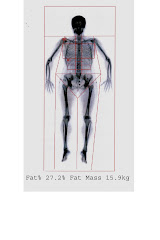I was asked the other week who (in their right mind) invented burpees - one of my lovely clients, Emma, did a quick Google search and found this info from Wikipedia.... so for those of you losing sleep at night wondering where the burpee came from or even what a burpee even is here's your answer:
The burpee is a full body exercise used in strength training and as aerobic exercise. It is performed in five steps:
Less challenging
The burpee is a full body exercise used in strength training and as aerobic exercise. It is performed in five steps:
- Begin in a standing position.
- Drop into a squat position with your hands on the ground.
- Kick your feet back while lowering yourself with a pushup.
- Return your feet to the squat position while straightening your arms.
- Leap up as high as possible from the squat position with your arms overhead (you may clap your hands above your head at the peak of your jump)
Less challenging
- Non-jump burpee
- The athlete returns to the standing position without leaping off the ground.
- Knee push-up burpee
- The athlete bends their knees and rests them on the ground while performing the push up.
More challenging
- Long-jump burpee
- The athlete jumps forward, not upward.
- Tuck-jump burpee
- The athlete pulls their knees to their chest (tucks) at the peak of the jump.
- Jump-over burpee
- The athlete jumps over an obstacle between burpees.
- Box-jump burpee
- The athlete jumps onto a box, rather than straight up and down.
- One-armed burpee
- The athlete uses only one arm for the whole exercise including the pushup.
- Dumbbell burpee
- The athlete holds a pair of dumbbells while performing the exercise.
- Parkour burpee
- Following one burpee on the ground, the athlete jumps upon a table and performs the second burpee on the table, then jumps back to the initial position.
- Hindu push up burpee
- Instead of a regular push up, do a hindu push up.
- Pull-up burpee
- Combine a pull-up with the jump or do a pull-up instead of the jump.
- Muscle-up burpee
- Combine a muscle-up (a variation of a pull-up) with the jump or do a muscle-up instead of the jump.
- Double burpee
- Instead of one push up, do two in a row. This cancels the drive from landing after the jump and makes the next jump harder. Each part of the burpee might be repeated to make it even harder.
- One Leg burpee
- The athlete stands on one leg, bends at the waist and puts hands on ground so they are aligned with shoulders. Next jump back with the standing leg to plank position. Jump forward with the one leg that was extended, and do a one-leg jump. Repeat on opposite side.
- Side burpee
- The athlete bends at waist and places hand shoulder-width apart to
the side of right or left foot. Jump both legs out to side and land on
the outer and inner sides of your feet. Jump back in, jump up, and
repeat on opposite side.
Origin - According to the Oxford English Dictionary, the exercise was named in the 1930s for American psychologist Royal H. Burpee, who developed the Burpee test. Consisting of a series of the exercises performed in rapid succession, the test was meant to measure agility and coordination. It is not clear whether the exercise itself was invented by Burpee, or if his test merely popularized it.
Maybe we will be introducing a few of those variations into our sessions......and for those who previously missed in here's a great little video of my son, Marley performing his own burpee.

























No comments:
Post a Comment